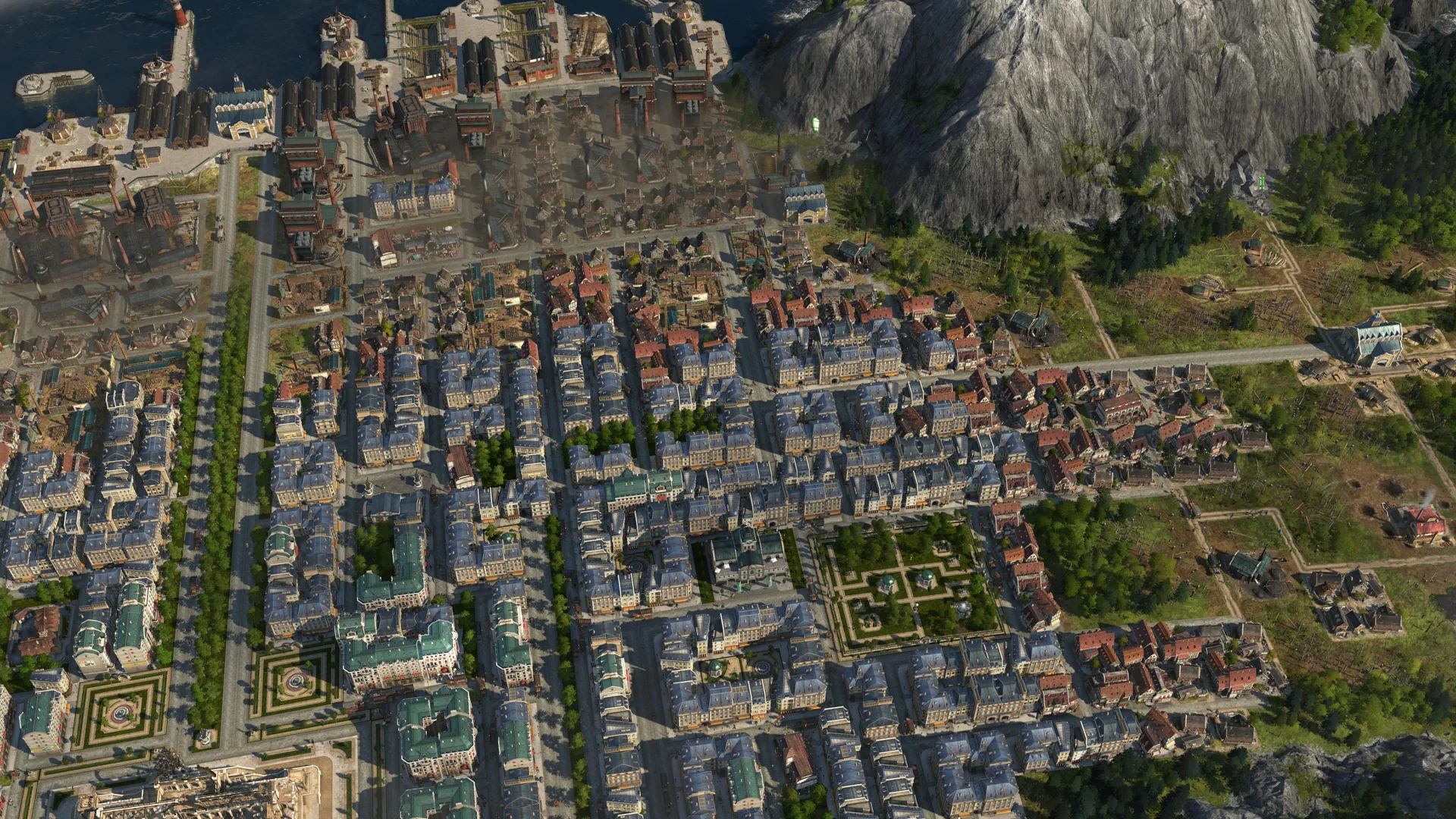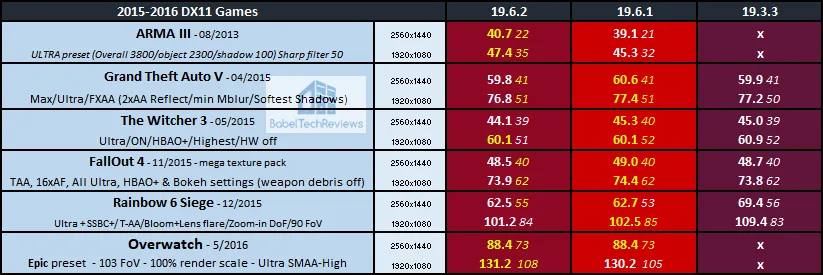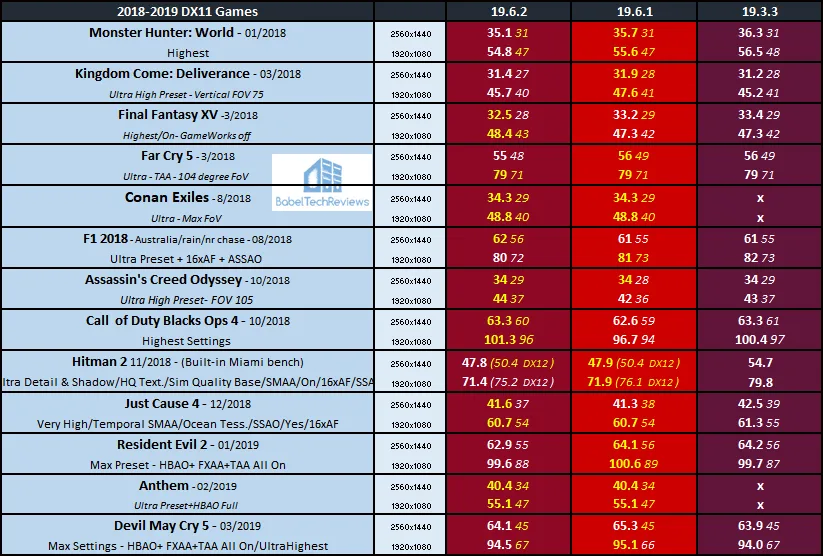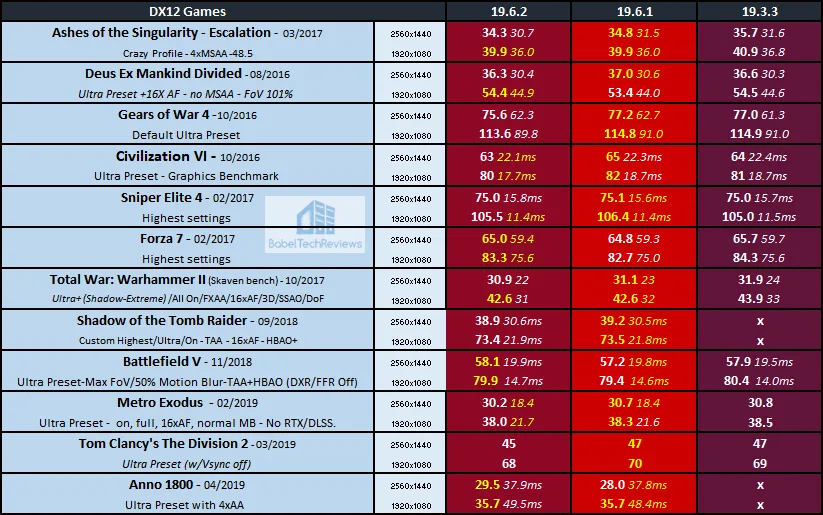Adrenalin Software Edition 19.6.2 Performance Analysis featuring the Red Devil RX 590 with 43 Games
As a BabelTechReviews regular feature, this Adrenalin Software Edition 19.6.2 Performance Analysis will chart the performance of 43 PC games using the latest drivers that released earlier this week. We will compare these 19.6.2 drivers with two sets of earlier drivers, 19.6.1 and 19.3.3, using the the Red Devil RX 590.
Earlier this month, we documented the performance changes of the latest Windows version 1903 from 1809 using two GeForce cards and found almost no performance changes in gaming. So by this testing, we may also infer if any RX 590 performance changes resulted from the May Windows upgrade.
We benchmark at 1920×1080 and at 2560×1440 resolutions using the latest games, and we also recently added Anno 1800, ARMA III, Conan Exiles, and ARK: Survival Evolved. In addition, Hitman 2 and TW: Warhammer II are run on DX11 and on DX12.
We recently upgraded our testing platform using a Core i7-8700K which turbos all 6 cores to 4.8GHz (from 4.7GHZ), an EVGA Z370 FTW motherboard, and 16GB of T-FORCE XTREEM DDR4 at 3866MHz (from 3333MHz) The games tested, settings, and hardware are identical except for the driver versions being compared.
Test Configuration – Hardware
- Intel Core i7-8700K (HyperThreading and Turbo boost are on to 4.8GHz for all cores; Coffee Lake DX11 CPU graphics).
- EVGA Z370 FTW motherboard (Intel Z370 chipset, latest BIOS, PCIe 3.0/3.1 specification, CrossFire/SLI 8x+8x), supplied by EVGA
- T-FORCE XTREEM (2×8 GB, dual channel at 3866 MHz), supplied by Team Group
- Red Devil RX 590 8 GB, at stock Red Devil speeds, on loan from PowerColor
- EVGA Nu Audio PCIe soundcard, supplied by EVGA
- 480 GB Team Group SSD
- 1.92 TB San Disk enterprise class SSD
- 2 TB Micron 1100 SSD
- Seasonic 850W Gold Focus power supply unit
- EVGA CLC 280mm CPU water cooler, supplied by EVGA
- Onboard Realtek Audio
- Edifier R1280T active speakers
- EVGA DG-77, mid-tower case supplied by EVGA
- Monoprice Crystal Pro 4K
Test Configuration – Software
- AMD’s Radeon Software Adrenalin Edition 19.6.2 is compared with 19.6.1 using Windows v1903. These two drivers’ performance are also compared with 19.3.3 using Windows v1809. In addition, the 19.3.3 performance results are from our earlier platform (i7-8700K at 4.7GHz instead of 4.8GHz; DDR4 at 3333MHz instead of 3866MHz).
- VSync is forced off.
- AA enabled as noted in games; all in-game settings are specified
- Gaming results show average frame rates in bold including minimum frame rates shown on the chart next to the averages in a smaller italics font.
- Highest quality sound (stereo) used in all games.
- Windows 10 64-bit Home edition v1903 and also v1809. All DX11 titles were run under DX11 render paths. DX12 titles are generally run under the DX12 render path unless performance is lower than with DX11; Hitman 2 and TW: Warhammer II are run on both pathways. Three games use the Vulkan API.
- Latest DirectX
- All games are patched to their latest versions at time of publication
- Wattman
- OCAT
- Fraps, latest version
- Yet Another ARMA Benchmark
43 PC Game benchmark suite & 3 synthetic tests
Synthetic
- Firestrike – Basic & Extreme
- Time Spy DX12
- Superposition
DX11 Games
- Grand Theft Auto V
- The Witcher 3
- Fallout 4
- Rainbow Six Siege
- Overwatch
- Battlefield 1
- For Honor
- Ghost Recon Wildlands
- Mass Effect: Andromeda
- Prey
- ARK: Survival Evolved
- Project CARS 2
- Middle Earth: Shadow of War
- Total War: Warhammer II
- Destiny 2
- Star Wars: Battlefront II
- Monster Hunter: World
- Kingdom Come: Deliverance
- Final Fantasy XV
- Far Cry 5
- Conan: Exiles
- F1 2018
- Assassin’s Creed: Odyssey
- Call of Duty: Black Ops 4
- Hitman 2
- Just Cause 4
- Resident Evil 2
- Devil May Cry 5
DX12 Games
- Tom Clancy’s The Division
- Ashes of the Singularity: Escalation
- Deus Ex Mankind Divided
- Gears of War 4
- Civilization VI
- Sniper Elite 4
- Forza 7
- Total War: Warhammer II
- Shadow of the Tomb Raider
- Battlefield V
- Hitman 2
- Metro Exodus
- Tom Clancy’s The Division 2
- Anno 1800
Vulkan Games
- DOOM
- Wolfenstein: The New Colossus
- Strange Brigade
AMD Control Center Radeon Settings
All AMD settings are set with all optimizations off; Vsync is forced off, Texture Filtering is set to High, and Tessellation uses application settings. These same settings are used across all drivers so that the driver performance of each edition can be compared identically. We used Wattman to set power and fan limits to their maximums to prevent throttling.
Adrenalin Software 19.6.2 Edition can be downloaded starting here. The release notes are found here. The included highlights below are taken directly from AMD’s website:
Radeon Software Adrenalin 2019 Edition 19.6.2 Highlights
Added Vulkan™ Support
- VK_EXT_host_query_reset
- Allows resets of queries from the host, rather than on the GPU.
- VK_EXT_full_screen_exclusive
- Gives applications explicit control over exclusive full-screen modes (this is for instance useful for HDR support).
- VK_AMD_display_native_hdr
- Exposes FreeSync2 capabilities for improved HDR support.
- VK_EXT_separate_stencil_usage
- Separates the usage flags for depth/stencil aspects of a depth/stencil image making it possible to restrict/expand the usage relative to the depth aspect.
- VK_KHR_uniform_buffer_standard_layout
- Provides more flexible alignment for uniform buffers, enabling among other things, the usage of std430 layouts in Vulkan.
Fixed Issues
- Wireless VR may experience performance drops across multiple game titles on some Radeon RX 400 and Radeon RX 500 series graphics products.
- Performance Metrics Overlay may fail to enable or may be disabled when toggling Radeon Overlay while in game.
- A TDR may occur when exiting some gaming applications that are using DirectX®12 API when multiple displays are connected and in clone mode.
- Microsoft® PIX tool may fail when a GPU is connected using AMD XConnect™ Technology.
- Crackdown™3 may experience an application or game hang on Radeon R7 370 series graphics products.
Known Issues
- Radeon ReLive streaming and uploading of videos and other content to Facebook™ is currently unavailable.
- ASUS TUF Gaming FX505 may experience discrete GPU connection issues with devices disappearing from device manager when the system is idle.
- Performance Metrics Overlay and Radeon WattMan gauges may experience inaccurate fluctuating readings on AMD Radeon VII.
- ACER Swift 3 with AMD Ryzen Processor may experience system instability when upgrading to Radeon Software Adrenalin 2019 Edition 19.6.2 using the Custom Clean Installation option.
- Graphics driver may not uninstall correctly when using the express uninstall option on some Ryzen APUs.
Important Notes
- AMD Ryzen™ Mobile Processors with Radeon™ Vega Graphics FAQ for Radeon Software Adrenalin 2019 Edition can be found here.
Package Contents
The Radeon Software Adrenalin 2019 Edition 19.6.2 installation package contains the following:
- Radeon Software Adrenalin 2019 Edition 19.6.2 Driver Version 19.20.01.07 (Windows Driver Store Version 26.20.12001.7006)
The Radeon Software Adrenalin 2019 Edition 19.6.2 installation package can be downloaded from the following links:
By clicking the Download button, you are confirming that you have read and agreed to be bound by the terms and conditions of the End User License Agreement (“EULA”). If you do not agree to the terms and conditions of these licenses, you do not have a license to any of the AMD software provided by this download.
###
Let’s head to the charts to compare the driver changes from two earlier Adrenalin Software Editions to the brand new Adrenalin Software 19.6.2 Edition which released earlier this week.
The Summary Charts
Below are the summary charts of 43 games and 3 synthetic tests. Each game’s performance is charted to compare the driver progression of the latest Radeon Software Adrenalin Edition 19.6.2. The highest settings are chosen, the driver versions and the specific settings are listed on the charts. The benches were run at 1920×1080 and at 2560×1440. Open each chart in a separate window or tab for best viewing.
Most results show average framerates and higher is better. Minimum framerates are next to the averages in italics and in a slightly smaller font. The games benched with OCAT show average framerates but the minimums are expressed by frametimes in ms where lower numbers are better.
Drivers 19.6.2 performance in column one is compared with 19.6.1 in column 2 on Windows v1903, and 19.3.3 performance on Windows v1809 is represented by column 3. Yellow text indicates a “win” for the highest performing result between 19.6.2 and 19.6.1, and if the performance is equal, both sets of numbers are given in yellow text.





 There are many minor incremental performance changes with our Red Devil RX 590 using the latest Adrenalin Software 19.6.2 drivers from either 19.6.1 or from 19.3.3 (on Windows v1809). We really don’t see any significant performance changes between our three sets of drivers except for a single performance regression with Rainbow 6: Siege that is most likely affected by a major update to the game since 19.3.3, and not by the Windows update.
There are many minor incremental performance changes with our Red Devil RX 590 using the latest Adrenalin Software 19.6.2 drivers from either 19.6.1 or from 19.3.3 (on Windows v1809). We really don’t see any significant performance changes between our three sets of drivers except for a single performance regression with Rainbow 6: Siege that is most likely affected by a major update to the game since 19.3.3, and not by the Windows update.
Let’s head to our conclusion.
Conclusion:
We would recommend upgrading to the latest Radeon Adrenalin Software Edition 19.6.2 from any previous driver set because there are some advantages that might be useful, depending on which game you are playing. We found this driver to be very stable and we encountered no significant issues with any of our games.

We are also glad to report that the Windows v1903 upgrade also had very little effect on our games’ performance and we also found no major issues with it with either GeForce or with Radeon cards.
Over time, Adrenalin software drivers show mostly continued positive performance improvement which may be more notable in some of the newer games. There were a few relatively insignificant incremental regressions, but overall the performance continues to improve.
The new features of the Radeon Adrenalin 2019 annual software update are being improved continuing with the 19.6.2 edition, and they are welcome and worth exploring. The advantages of using the latest drivers generally outweigh any disadvantages.
We are continuing to add new games to our benching suite with an eventual goal of 50. If you would like to make a request for other games to be added or dropped, please let us know in the Disqus comment section below.
Next week we will post a virtual reality (VR) performance comparison between GeForce and Radeon video cards.
Happy gaming!
